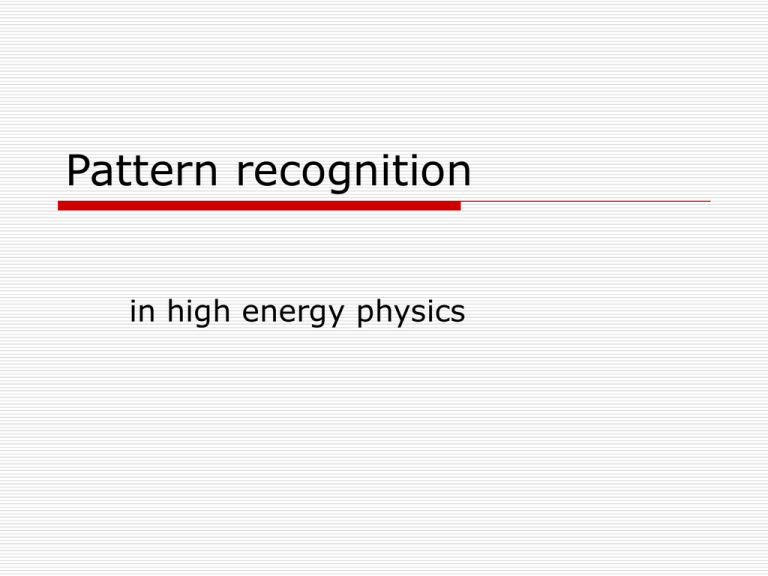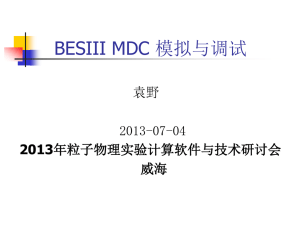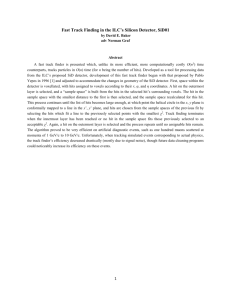A Concurrent Track Evolution Algorithm for Pattern Recognition in
advertisement

Pattern recognition
in high energy physics
Measurement system
Measurement system
Measurement system
The forward
spectrometer is
located downstream
of the interaction
region and measures
charged particle
tracks at small polar
angles q below 5
degrees in the vertical
and 10 degrees in the
horizontal plane.
Measurement system
Measurement system is
comprised of a total of six
stations with four straw
tube double layers each,
two of which have
vertical wires, the other
two have wires inclined
by 5 degrees. Chambers
1 and 2 will be placed in
front, 3 and 4 within, 5
and 6 behind the dipole
magnet.
Measurement system
Reconstructing coordinates from stereo views
Measurement system
Reconstruction of particles
Track finding (pattern recognition)
Global methods
Local methods
Track fitting
Usually least squares
Global methods
Template matching
Histogramming
Hough transform
Legendre transform
Neural networks
Elastic arms
Template matching/tree search
Hough transform
Legendre transform
Alexopoulos, T., et al., 2008: Implementation of the Legendre
Transform for track segment reconstruction in drift tube chambers
Nucl. Instrum. Methods Phys. Res. A 592, 456.
Legendre transform
For a value p of the slope the Legendre
transform of the function f is defined as
follows:
The equation of a circle with center (x0, y0) and
radius R is given by:
Legendre transform
The Legendre transform of the circle
is:
Neural networks
The basic idea is to associate each possible
connection between two hits with a neuron.
Activation of such a neuron means that both
hits are part of the same track. This desired
behaviour can be obtained by an energy
function:
Neural networks
Neural networks
Local minima
To overcome the problem some
complicated cost function are
necessary
Elastic arms
The basic idea can be described as follows:
a set of M deformable templates is created,
which correspond to valid parametrizations
of tracks with parameters {t1, ... tM}.
The algorithm should then move and
deform these templates such that they fit
the pattern given by the positions of N
detector hits, which are represented by {ξ1
... ξN}.
Elastic arms
We need an activation-like quantity Sia whose
value is one if hit i is assigned to track a, and
zero otherwise, and a function Mia(ξi, ta)
describing a metric between track template
and hit, typically the square of the spatial
distance. The energy function can then be
defined as:
Elastic arms
The main challenge is to find the global
minimum of the energy function
Simulated annealing is used
Method is time-consuming and requires very
good initialization
Local methods
Track following
Kalman filter
(http://www-lc.kek.jp/subg/offl/kaltest/)
Track following
Seeds
Seeding schemes with nearby
layers
Creating seeds from drift chamber
hit triplets.
Track following
Naive track following
Starting from a seed, the trajectory is
extrapolated to the detector part where the next
hit is expected.
If a suitable hit is found, it is appended to the
track candidate.
Where several hits are at disposal, naive track
following selects the one closest to the
extrapolated trajectory.
This procedure is continued until the end of the
tracking area is reached, or no further suitable
hit can be found.
Track following
The main drawbacks of the naive
scheme:
Some expected hits may be missing
because of limited device efficiency.
Wrong hits may be closer to the
presumed trajectory than the proper hits
and be picked up in their stead.
Left-right ambiguities in wire drift
chambers double the number of choices.
Track following
Combinatorial Track Following
In each track following step, each continuation
hit which is possible within a wide tolerance
gives rise to a new branch of the procedure.
In general a whole tree of track candidates
emerges.
The final selection of the best candidate must be
done in a subsequent step, which may involve a
full track fit on each candidate.
This kind of method is potentially unbeatable in
terms of track efficiency, but in general highly
resource consuming and therefore only used in
special cases with limited combinatorics.
Track following
Arbitration
In practical applications of track
following, means are required to reduce
its dependency on the starting point, and
to decrease its vulnerability against
stochastic influences.
Track following
Arbitration
It is mandatory not to depend on a single option
of seeding tracks, which would lead to loss of a
track if one of the seeding layer happens to be
inefficient.
When an expected hit appears to be missing in a
layer during propagation, it may be advisable
not to discard the candidate immediately, but to
proceed further until a fault limit is exceeded.
In a case where more than one hit could present
a suitable continuation for a track, one might
want not to decide immediately for the closest
hit but create branches.
Arbitrated track following
1. R. Mankel, A Concurrent Track Evolution Algorithm for Pattern
Recognition in the HERA-B Main Tracking System, Nucl. Instr. and
Meth. A395 (1997) 169-184
2. R. Mankel and A. Spiridonov, The Concurrent Track Evolution
Algorithm: Extension for Track Finding in The Inhomogeneous
Magnetic Field of The HERA-B Spectrometer, Nucl. Instr. and Meth.
A426 (1999) 268-282.
Kalman filter
Dynamic process
Measurement
Kalman filtering involves three steps:
Prediction – the estimation of the state vector at
a future time
Filtering – the estimation of the present state
vector based on past measurements
Smoothing – the estimation of the state vector
in past based on all measurements taken to
present
Kalman filter
R. Frühwirth: Application of Kalman filtering to
track and vertex fitting, Nuclear Instruments and
Methods in Physics Research Section A: Volume 262,
Issues 2–3, 15 December 1987, Pages 444–450
Bo Li, Keisuke Fujii,Yuanning Gao , Kalman-filterbased track fitting in non-uniform magnetic field with
segment-wise helical track model, arXiv 1305.7300v2
[physics.ins-det]
C++library for Kalman filtering (linear and non-linear
propagation):
http://www-lc.kek.jp/subg/offl/kaltest
Metrics of algorithm quality
Assessment of track finding efficiency requires
firstly a definition of a reference set of tracks
that an ideally performing algorithm should
find. Normally tracks will be provided by a
Monte Carlo simulation, and the selection of
reference tracks will depend on the physics
motivation of the experiment.
Metrics of algorithm quality
Hit matching
This method analyzes the simulated
origin of each hit in the reconstructed
track using the Monte Carlo truth
information. If the qualified majority of
hits, for example at least 70% originates
from the same true particle, the track is
said to reconstruct this particle.
Metrics of algorithm quality
Parameter matching
The reconstructed parameters of a track
are compared with those of all true
particles. If the parameter sets agree
within certain limits (which should be
motivated by the physics goals of the
experiment), the corresponding track is
said to reconstruct this particle.
Metrics of algorithm quality
The reconstruction efficiency is defined as:
One should also control the abundance of nonreference tracks which are reconstructed:
Metrics of algorithm quality
Tracks produced by the pattern
recognition algorithm that do not
reconstruct any true particle within or
without the reference set are called
ghosts. A ghost rate can be defined
as:
Metrics of algorithm quality
Redundant reconstructions of a single particle
are called clones. For a given particle m with
Nrecom tracks reconstructing it, the number of
clones is:
Clone rate:
Metrics of algorithm quality
The quality of the estimate of a track parameter Xi is
reflected in the parameter residual:
The estimate of the parameter covariance matrix can be
used to define the normalized parameter residual
Ideally, the pull should follow a Gaussian distribution
with a mean value of zero and a standard deviation of
one.
Solution?
Totally we have 8 vertical layers of straws
before the magnet
For 10 degrees for the scattered particles,
we have to examine a region of about 1 m
width, 3 meters from the target
For typical straw diameter (about 5 mm),
about 200 straws will be examined in each
of 8 layers
Solution?
Template based tree search can be used to find
the track candidates (we need at most 8 levels
of the template hierarchies) – it can be
implemented in hardware.
Solution?
For each track matched to a template
the Legendre transform can be used
to find the single track parameters in
xz plane – implemented in hardware
(like Hough transform)
Solution?
We have 8 stereo layers to
reconstruct tracks in yz plane
Solution?
„Drift” circles are mapped to elipses
on S plane.
Stereo angles are constant
After rescaling vertical coordinate
(multiply by sin(5O))we get circles on
S plane.
Then we can apply Legendre
transfrom to find the single track in S
plane.
Magnetic field region
Can we assume Bx = Bz = 0, By =
const?
If not – general methods for
inhomogeneous field, based on
measurements of B(x,y,z).
If yes:
Fx = -vz*By
Fy = 0
Fz = vx*By, Fz << Fx => parabola
Magnetic field region
Independently on assumptions about B,
track following methods can be used
starting from seed tracks found in either
the outer on the inner region.
If B vertical and homogeneous, problem
can be split into two 2D problems.
If not – full 3D tracking must be
implemented.
Magnetic field region
We can use track-following methods of:
R. Mankel, A Concurrent Track Evolution
Algorithm for Pattern Recognition in the HERA-B
Main Tracking System, Nucl. Instr. and Meth.
A395 (1997) 169-184
R. Mankel and A. Spiridonov, The Concurrent
Track Evolution Algorithm: Extension for Track
Finding in The Inhomogeneous Magnetic Field of
The HERA-B Spectrometer, Nucl. Instr. and
Meth. A426 (1999) 268-282.









